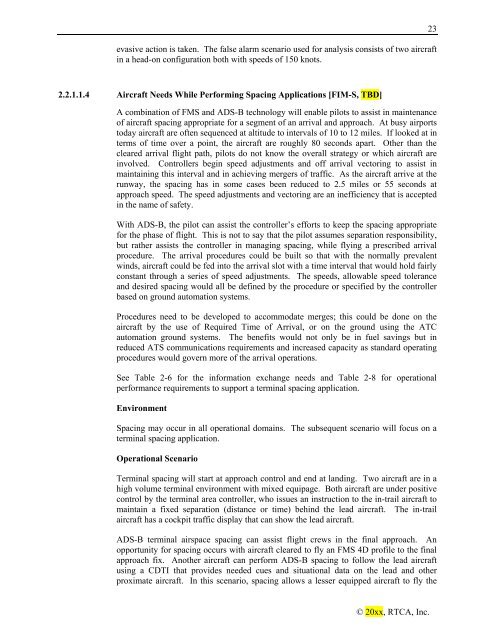Minimum Aviation System Performance Standards for Aircraft ...
Minimum Aviation System Performance Standards for Aircraft ...
Minimum Aviation System Performance Standards for Aircraft ...
You also want an ePaper? Increase the reach of your titles
YUMPU automatically turns print PDFs into web optimized ePapers that Google loves.
evasive action is taken. The false alarm scenario used <strong>for</strong> analysis consists of two aircraft<br />
in a head-on configuration both with speeds of 150 knots.<br />
2.2.1.1.4 <strong>Aircraft</strong> Needs While Per<strong>for</strong>ming Spacing Applications [FIM-S, TBD]<br />
A combination of FMS and ADS-B technology will enable pilots to assist in maintenance<br />
of aircraft spacing appropriate <strong>for</strong> a segment of an arrival and approach. At busy airports<br />
today aircraft are often sequenced at altitude to intervals of 10 to 12 miles. If looked at in<br />
terms of time over a point, the aircraft are roughly 80 seconds apart. Other than the<br />
cleared arrival flight path, pilots do not know the overall strategy or which aircraft are<br />
involved. Controllers begin speed adjustments and off arrival vectoring to assist in<br />
maintaining this interval and in achieving mergers of traffic. As the aircraft arrive at the<br />
runway, the spacing has in some cases been reduced to 2.5 miles or 55 seconds at<br />
approach speed. The speed adjustments and vectoring are an inefficiency that is accepted<br />
in the name of safety.<br />
With ADS-B, the pilot can assist the controller’s ef<strong>for</strong>ts to keep the spacing appropriate<br />
<strong>for</strong> the phase of flight. This is not to say that the pilot assumes separation responsibility,<br />
but rather assists the controller in managing spacing, while flying a prescribed arrival<br />
procedure. The arrival procedures could be built so that with the normally prevalent<br />
winds, aircraft could be fed into the arrival slot with a time interval that would hold fairly<br />
constant through a series of speed adjustments. The speeds, allowable speed tolerance<br />
and desired spacing would all be defined by the procedure or specified by the controller<br />
based on ground automation systems.<br />
Procedures need to be developed to accommodate merges; this could be done on the<br />
aircraft by the use of Required Time of Arrival, or on the ground using the ATC<br />
automation ground systems. The benefits would not only be in fuel savings but in<br />
reduced ATS communications requirements and increased capacity as standard operating<br />
procedures would govern more of the arrival operations.<br />
See Table 2-6 <strong>for</strong> the in<strong>for</strong>mation exchange needs and Table 2-8 <strong>for</strong> operational<br />
per<strong>for</strong>mance requirements to support a terminal spacing application.<br />
Environment<br />
Spacing may occur in all operational domains. The subsequent scenario will focus on a<br />
terminal spacing application.<br />
Operational Scenario<br />
Terminal spacing will start at approach control and end at landing. Two aircraft are in a<br />
high volume terminal environment with mixed equipage. Both aircraft are under positive<br />
control by the terminal area controller, who issues an instruction to the in-trail aircraft to<br />
maintain a fixed separation (distance or time) behind the lead aircraft. The in-trail<br />
aircraft has a cockpit traffic display that can show the lead aircraft.<br />
ADS-B terminal airspace spacing can assist flight crews in the final approach. An<br />
opportunity <strong>for</strong> spacing occurs with aircraft cleared to fly an FMS 4D profile to the final<br />
approach fix. Another aircraft can per<strong>for</strong>m ADS-B spacing to follow the lead aircraft<br />
using a CDTI that provides needed cues and situational data on the lead and other<br />
proximate aircraft. In this scenario, spacing allows a lesser equipped aircraft to fly the<br />
© 20xx, RTCA, Inc.<br />
23
















